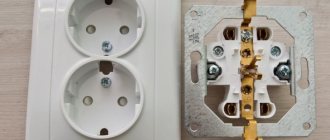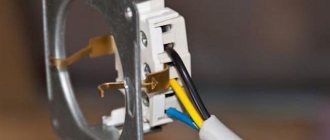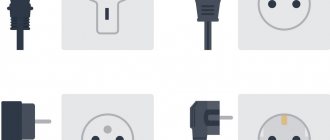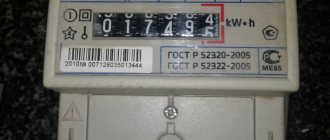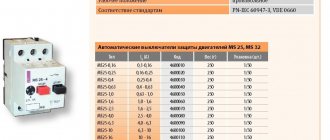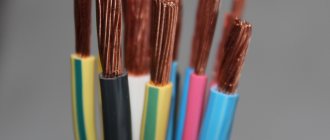Sockets are used to temporarily connect consumers to the electrical network. Their previous types were bipolar. Later, sockets with grounding appeared. At first these were three-phase sockets for 380, then they were followed by the so-called. European socket. Grounded outlets meet new electrical safety standards.
Structurally and in materials, sockets are in many ways similar to switches. The socket device includes a contact socket holder (base), the sockets themselves, their terminals for power wires and a housing. The base has mounting holes or push-down stops for hidden sockets.
Double pole sockets
These, with a round shape of plug contacts, are used in everyday life and offices for a voltage of 220 V in Europe and Russia. (In the USA and Japan 115 V with flat contacts). They can be with or without grounding. Grounded sockets are now replacing those still in use without grounding with a “thin” plug.
The Euro socket becomes the de facto standard and has thicker pins that are incompatible with older sockets. Previously, the only place for their attachment was walls, then, for the convenience of consumers, they began to be built into equipment and furniture. There are now different types on the market to suit all occasions.
Grounded outlets are also considered double-pole because the ground does not provide a path for operating current but serves only for protection purposes. They require a ground bus, although in many places they work without it. For example, in places where electrical network equipment has been preserved since the fifties of the last century.
Built-in sockets are used for convenience and space saving. For example, built-in sockets for the kitchen can be located in rotating and retractable housings built into the kitchen furniture. This makes it easier to work with electrical appliances, since the convenient location of the sockets significantly reduces the risk of the consumer getting caught on the cord and knocking something over or falling.
If they are not needed, they can be removed by pressing the housing or turning it. The sockets are hidden and the furniture looks more attractive. Pull-out sockets for countertops are usually designed as a triple socket - in the kitchen they often connect two appliances at the same time and a reserve would not hurt, so a triple socket is very optimal in this design.
In addition to such new products as retractable sockets for the kitchen, sockets with a timer are appearing on sale. Their purpose is to help save energy or create the impression that there are people in the house (to protect against burglars). Sockets with a timer are produced in several modifications. The simplest and most inexpensive models are combined with a mechanical countdown timer.
More advanced sockets with a timer, instead of mechanics, use a controller with a display and buttons for programming it. They allow you to create a schedule from many points or cycle a sequence of switching off and turning on. Naturally, they cost more.
All receptacles with a timer must provide at least 16 amps of current without overheating the contacts during continuous operation. The fact is that sockets with a timer are switched by electromagnetic relays; semiconductor switches do not provide electrical safety in terms of leakage currents (if the socket is disconnected, you can get an electrical injury).
Triple sockets in combination with a timer are rarely used, since each output must be controlled separately (except for very simple models with a mechanical timer), and this complicates the design. Manufacturers understand how easy it is to mislead consumers and do everything to eliminate any misunderstandings.
Child-resistant sockets are also available. Small children can become energized due to their curiosity, so on such products they use a mechanical blocking of access to its sockets, designed so that only adults or children of a sufficiently responsible age can overcome it.
Ceiling sockets are used to connect a chandelier; this is a completely separate type of socket. Also, stationary sockets built into the floor are not used - this is unacceptable in terms of electrical and fire safety and they will easily become littered with dust.
In addition to 220 V network sockets, sockets for other purposes appear in the same sizes, among which TV sockets for connecting televisions to antennas or cable networks have begun to occupy a prominent place. They are divided into two groups: there are end (terminal) sockets and pass-through sockets. The feed-through socket must provide a matched characteristic impedance for the subsequent pass-through or termination socket.
When planning the location of subscriber devices in rooms (TVs or computers), you need to take into account what is called the network topology. Usually for private consumers this is a very simple single-line chain of two or three through sockets and one terminal socket, sometimes there are branches. It is important to remember that a pass-through TV socket can be not only a pass-through, but also a tee, this helps optimize the length of the cables.
For outdoor use, outdoor sockets are used. Outdoor sockets are made in a protected design, from IP44 and higher. The double external street socket is the most common; hidden (mounted flush with the surface) street sockets are not used, they don’t even have a designation in GOST 21.614–88.
An outdoor outlet in this design is too vulnerable to moisture and unsafe. A double external socket often helps to get rid of unnecessary extension cords, which can be unsafe in wet soil and grass.
Three-pole sockets
380 volt sockets are made three-pole - one pole per phase. Almost all of these sockets are grounded; according to the new rules, this is mandatory. The 380 socket is made much more durable, using non-flammable materials.
A fire resulting from a short circuit in such an outlet is very impressive, since significantly greater power is transmitted in three-phase circuits than in single-phase circuits. Almost every three-phase outlet is external. All 380 V sockets are sealed with rubber bushings and gaskets to prevent moisture and dust from getting inside.
Designations of sockets for diagrams and drawings
To designate rosettes, a semicircle with an arc upward is used. The designation on the drawings differs from the image on the circuit diagrams. The figure shows several illustrative examples of notation.
Two-pole sockets are indicated by one stroke, three-pole sockets - by three strokes emanating from a common point and directed upward. There are no notations with two strokes from a common point. Two parallel strokes indicate a double two-pole socket (See GOST 21.614–88 for more complete information.).
A socket with a grounding contact is indicated by a horizontal stroke running tangentially. This is not a sign of a hidden installation, as some people think. A socket for installation in walls is indicated by a vertical line inside a semicircle. Symbols for sockets can be supplemented by symbols of switches (“poker”) - L-shaped strokes, if they are performed in conjunction with them.
All these designations have nothing to do with the connection, the latter are carried out according to the electrical circuit diagram, this is a completely different document. A wiring drawing is required only for installing sockets and switches, installing panels and laying wiring routes. The connection is made later to avoid confusion. You can read more about connecting sockets here.
Installation Rules
Standards for the location of sockets and switches
In order for the socket to work for a long time, reliably and safely after installation, you need to follow simple rules:
- The electric point should be installed at a height of 30 to 80 cm from the floor level, with the exception of above-plinth models.
- Models equipped with a grounding contact should be installed no closer than 50 cm from appliances or a gas pipe.
- If there are children in the house, sockets should be installed higher.
- Single or double plug sockets for hidden installation should be encased in an iron or plastic case, and the wire reserve in them should be 5-6 cm.
- When laying a new power supply line, you should immediately take care of installing power points.
- If you need to place several sockets in a row at once, you can use boxes designed to install two sockets at once. When installing a larger number, you should prepare a group of socket boxes that are secured to each other.
- You can use a “loop” connection scheme, when the contacts of the previous outlet are combined with the power of the next one, or you can use the option of connecting to a separate line.
Before proceeding with the installation of the plug socket, it is imperative to turn off the power supply and also use the indicator to check the voltage.
What is a household plug socket?
November 14, 2013
A plug socket is one of the components of the electrical network, without which the task of connecting devices becomes significantly more complicated. Despite the large number of existing models (waterproof, dual, grounded), the basic principle remains unchanged. Indeed, a plug socket makes it possible, at minimal cost, to provide a safe connection to the network of electrical appliances for anyone, even without a security clearance.
Although the plug socket is a structurally complete device, it cannot be fully operated without a plug, with which it creates a detachable connection using copper sliding contacts. In other words, the consistency of the solutions used is important. For example, a plug socket with two sockets (holes) is designed for a corresponding plug with the same number of pins (pins), and the diameter should not exceed the permissible value.
Let's consider what features are inherent in sockets used in household electrical networks. One of the key differences is the case material (not to be confused with the outer cover). The socket can be made of ceramic or flame retardant plastic. The latter, despite its high performance characteristics, is inferior in terms of resistance to heat (it deforms at high temperatures, caused, for example, by poor contact crimping) and permissible breakdown voltage (the best insulators are glass and ceramics, not polymers).
Now that outdated home wiring is being replaced everywhere, a plug socket with a grounding contact is becoming indispensable. If in Soviet times a two-wire network (zero and phase) was considered the standard, now, in accordance with the requirements of the PUE, a grounding loop is installed and a third grounding wire is additionally installed. This significantly improves electrical safety. It connects to a special contact in sockets. Equipment that requires the use of grounding is sold with special plugs in which the housing is connected to the third contact. When you turn on the plug, not two wires come into contact, as before, but three wires. Such sockets can be of two modifications: when the plug has three pins that fit into the holes as standard, and also (a more convenient solution) when there is a spring-loaded sliding contact, which additionally secures the plug when it is turned on. The peculiarity of the latter is that when turned on, a grounding circuit is first created, and then deep power conductors are created. In retail chains you can find sockets of a special design, in which the holes are closed with plastic curtains, which need to be moved with pins to insert the plug.
Installation of plug sockets
There are models for external (open) and internal installation. Sockets of the first type are used, as a rule, in conjunction with external wiring, in which the wires are not hidden in the wall, but are fixed to small insulators or placed in cable ducts. Usually these are industrial premises, barns, street chains. If the lower part of the socket is not equipped with a closing cover, then you need to attach a plate of non-conductive material (textolite, wood) to the base. Then disassemble the socket body and use screws or bolts to place it on the prepared area. Wiring can be connected both before and after installation on the base (necessarily in a de-energized state of the network).
Models for hidden installation are equipped with internal metal “paws”, which, when tightening two screws, move apart, securely fixing the entire structure inside the mounting box. Installation is simple: a hole is prepared in the wall, the diameter and depth of which correspond to the selected plastic installation box; then a channel is made for the wire from the main line; the ends of the wires are connected to the socket terminals intended for this purpose; fixation is in progress; the outer cover is installed.
Incredible Transformations: 16 Prisons That Have Been Converted into Luxury Hotels If you're looking for an unforgettable experience on your trip, consider choosing a unique hotel, such as one that used to be a prison.
How to look younger: the best haircuts for those over 30, 40, 50, 60 Girls in their 20s don’t worry about the shape and length of their hair. It seems that youth is created for experiments with appearance and daring curls. However, already last.
Contrary to all stereotypes: a girl with a rare genetic disorder conquers the fashion world. This girl's name is Melanie Gaydos, and she burst into the fashion world quickly, shocking, inspiring and destroying stupid stereotypes.
7 Body Parts You Shouldn't Touch with Your Hands Think of your body as a temple: you can use it, but there are some sacred places that you shouldn't touch with your hands. Research showing.
13 signs that you have the best husband Husbands are truly great people. What a pity that good spouses don't grow on trees. If your significant other does these 13 things, then you can s.
9 Famous Women Who Have Fallen in Love with Women Showing interest in people other than the opposite sex is not unusual. You are unlikely to be able to surprise or shock anyone if you admit it.
Installation of hidden type sockets
Here we have described the installation step by step. Here are the main steps:
- First you need to choose the installation location.
- Make a hole for the box.
- The cable for this type of sockets must have three cores.
- You need to pull the cable cores through special holes that are located in the installation box.
- Strip the ends of the wires.
- Secure the block in any way.
- Install the plastic housing.
Overview of recessed and non-recessed type sockets
Scientific and technological progress allows us to gain access to new gadgets every day that make our lives easier. Most of them require an electrical connection to operate, which is provided by a plug socket. This is a switching node - a point that organizes the connection of a common and separate, independent circuit (electrical circuit of the gadget).
In fact, this term hides an ordinary household socket, but the scope of its application, the conceptual and practical decisions of manufacturers, and operating conditions influence the characteristics of the equipment.
- What is the socket for?
- Socket device
- Types of plug sockets Design differences
- Electrical diagram
- Protection level
- Number of working pads
- Performance indicators
What is the socket for?
Imagine a situation where you need to get inside a house in order to be able to use the benefits hidden there. To do this, first of all you need to find the front door, then use it for its intended purpose. If we draw some parallels and analogies, then any portable or stationary device or equipment must look for a connection point to the electrical network in order to be able to realize its purpose. Such a point, the input, is a two-pole plug socket.
Taking into account the general high dynamics of social life, the specifics of switching on electrical equipment, the socket, its dimensions and structural elements should provide the owner with the ability to quickly and reliably switch the circuit - close or open contacts. This effect is achieved due to the special layout of the connection, which is a combination of plug (plug) and socket (actually, socket).
Socket device
Any socket consists of three main parts:
- Protective and decorative body;
- Mounting block;
- Contact block.
The body consists of a front decorative frame (lid) and a socket box. The frame hides the connection block from the outside, forming a socket for the plug. The socket box limits the block with contacts from the back and sides, forming a kind of pocket. It can be part of the socket if it is a non-recessed type (surface) with open wiring, or mounted separately in a wall hole if the socket is built-in (recessed).
The block is a ceramic block containing contacts and fasteners for installation in a socket box and fastening the cover.
Contacts are either key or screw type. They differ in size and configuration. They have a two-way connection: the phase, neutral, and grounding (if any) wires from the network are connected on the inside, and the contact legs of the plug are connected on the front side. Contact elements are made of elastic metals.
Options
First, let's look at the markings of plug-type sockets. The designation consists of letters and numbers, for example:
RSH-Ts-20-0-01-10/220 is a recessed plug socket with open wiring, single-phase, from a series with grounding, used in a 220 V, 50 Hz network.
Let's look at the technical characteristics of various plug sockets.
Small-sized model RS-16-006 hidden installation:
| Voltage, V | 250 |
| Current, A | 16 |
| Protection | IP20 |
| Climatic requirements | UHL 4 |
| Overall dimensions, mm | 80x80x30 |
| Poles | 2 |
Photo - RS-16-006
Plug socket PS-326-100 (IEK brand) - recessed type with open wiring:
| Current, A | 40 |
| Voltage, V | 24 |
| Number of contacts | 7 |
Can be used for VAZ, KAMAZ, KRAZ trailers, etc.
Low-voltage plug socket 42V RP-2B (РШ-п-2-о-IP43-01-10/42) recessed type with hidden wiring for a portable or table lamp
| Voltage, V | 42 |
| Dimensions, mm | 61x61x50 |
| Current, A | 10 |
| Climate | UHL |
| Number of poles | 2 |
Neutral small-sized plug sockets type NMSh (ANShM2-310) for relays (their installation diagram is somewhat different from classical models):
| Resistance, Ohm | 310 |
| Voltage, V | 12 |
| Anchor release, V | 6,7 |
| Release time, s | instantly |
NMS
Types of plug sockets
There are plenty of criteria for evaluation. The main ones can be considered design (dimensions for mounting elements), electrical circuit, level of protection, number of working blocks, technical characteristics, etc.
Our readers recommend!
To save on electricity bills, our readers recommend the Electricity Saving Box. Monthly payments will be 30-50% less than they were before using the saver. It removes the reactive component from the network, resulting in a reduction in load and, as a consequence, current consumption. Electrical appliances consume less electricity and costs are reduced.
Design differences
In terms of design, or, more precisely, installation diagram, the plug socket can be recessed or external. In the first case, the socket box is missing as a component - it is a plastic cup for mounting the block elements, built into the prepared hole.
This is the most commonly used design because it has an obvious decorative effect: when the wiring is hidden, a thin frame can be seen from the outside. Surface-mounted sockets, on the contrary, have a composite socket box that is mounted on the wall. In this case, an open network is used. Its visual differences can be seen in the illustration below (upper left corner and right side).
Electrical diagram
According to the organization of electrical connection, the plug socket can be two-pole or three-pole (with a grounding contact). In everyday practice, both are used - it all depends on the presence of organized grounding or its absence. Visually they differ from each other by the metal brackets protruding into the plug socket.
Protection level
Connection points can be located in places with different moisture concentration conditions. This forces us to take some constructive measures to protect contacts. In practice, semi-hermetic and hermetic plug sockets are used, which have different levels of connection protection, and therefore different areas of application. There are different solutions, from the use of a protective shutter mechanism for openings to closing covers (in the illustration above).
Number of working pads
With the ever-growing number of household appliances dependent on electricity, the question of the number of connection points arises. A striking example of this is the kitchen. But sticking a sufficient number of sockets around the perimeter is not an option, since this is an expensive, labor-intensive process, with an extremely unaesthetic result. It’s another matter if you place several group points that combine from two to four or more outlets. In this case, the front part can be either single or modular.
Performance indicators
Each socket has its own technical characteristics, which limit its scope of application. These include:
- Degree of protection (moisture-proof, ordinary sockets);
- Rated current (is at the level of 10-16 A);
- Rated voltage (sockets are divided into two-phase, three-phase, etc.);
- Installation dimensions.
Design features
A semi-hermetic and sealed plug socket is part of a connection that also includes a plug, used to connect individual household appliances, switches, etc. Structurally, an electrical socket consists of a block, a protective housing and working contacts. In addition, the device also has a housing, which serves as a base.
Photo - adapter
The block is the most important design element. It is made from ceramic, thermoplastic or specially treated polycarbonate. For installation in residential premises, previously only models with ceramic pads were used, since they have excellent fire protection, but at the same time, they break from the slightest blow. Therefore, now only plastic bases are mainly used.
Photo - cable
Thin plates made of brass, copper, and bronze are used as working contacts. They are installed on the block using screw connections, a screw with a washer, or a spring (the most modern version). Spring connections are the most convenient to use. In the case, a button is connected to a spring that opens the panel and contacts. When you press the button, the spring is compressed and access to the protective and working contacts is opened.
Photo - description of the tap circuit, ammeter and lamp
The contacts are also protected by special curtains for plug connections. When the plug enters the holes, they move away to provide access to live cables. There are models with different connectors and their types. Their durability may vary depending on the type. The simplest ones are of the plate type and can wear out even from daily connections and shutdowns of devices. To extend their service life, the curtains are additionally reinforced with steel rings, transverse strips of brass or steel.
Installation of individual electrical points
After selecting specific products and laying the wiring, installation of plug sockets is carried out. It all depends on which design scheme is chosen.
For a recessed two-pole socket with or without a grounding contact, a hole is first made in the wall at the location where the socket box is installed. The choice of tool (hammers, grinders, core drills, etc.) depends on the surface material. At the connection stage (after installing the glass), the terminal block with fasteners is separated from the decorative frame, the elements are installed and secured in the socket box. After this, the front panel is screwed on and the installation can be considered complete.
Surface-mounted sockets for an open network are also disassembled before installation, but unlike a recessed one, there is no need to groove the walls. The socket box with the terminal block is screwed with dowels to the surface. After this, the wires are connected and the cover is installed.
A plug socket is one of those elements that surround a person in his everyday and professional activities. However, their choice should be treated quite scrupulously, because the safe operation of all electrical appliances and the network itself depends on it.
How to connect sockets
Fastening the wire using clamp terminals
Two-pole plug sockets with a grounding contact can be of several types. Only three key designs can be found on the Russian market, the names of which differ according to the country of origin, where they are often manufactured and are most common.
- French. In this design, the ground pin is a simple pin that fits into the plug when connected to an outlet. For such a connection, a special plug must be used, the hole in which will correspond to the pin.
- German. The main difference of this design is the presence of special clamps located on the sides and serving as a grounding contact. This approach ensures not only the ability to quickly connect the ground loop, but also convenient fixation of the plug in the socket.
- American. It differs in the location of the grounding contacts in special holes in the main connectors of the structure.
Hidden
Hidden socket with protective contact
Most often, this version of plug sockets is used when wiring indoors. The main part is located inside the wall, the protective housing is placed in the installation box and almost does not extend beyond the plane of the wall. The node through which the wires are connected is installed in such a way as to completely eliminate the possibility of squeezing out the cables. The tightness of the fork is ensured by the use of a spring washer.
Outdoor
Outdoor Receptacle with Safety Shutter
Basically it is part of exposed wiring and is fixed to the wall. The base is located in a plastic case, fixed to the wall using a special socket. The design includes a backlight, a switch-off timer, and a child-resistant lid.
Waterproof
A special category of sockets intended for use in rooms with a high degree of humidity: bathrooms, swimming pools or baths. The main difference from the conventional version is the presence of a special membrane, which is used as a reliable barrier protecting the working contacts. Plastic curtains and covers are equipped with an internal flange, through which water and accumulated condensate are drained.
Plug sockets differ in the number of contacts
- Two-pin;
- Three-pin. a) with flat contacts - two power and one ground; b) combined - with two cylindrical power contacts and one flat grounding contact;
- Four-pin – with flat contacts (3 power and 1 ground).
Currently, grounding contacts are installed on modern domestic models and on all foreign sockets. As I already wrote, a grounding contact removes static electricity and is necessary for long-term safe operation of electrical appliances (electric kettles, electric water heaters, air conditioners, computers, TVs). The old Soviet-style wiring does not have a grounding contact.
Features of the plug socket
I would like to note that there are some differences between sockets and plugs of domestic and foreign production.
The socket of a European-made plug socket has a larger diameter than the sockets of domestic sockets. The distance between the pins of European forks is greater than that of domestic ones. A European-made plug socket is designed for a current of 10 or 16 A, while our Russian sockets are designed for a current of 6.3 or 10 A. The diameter of the pin for a domestic plug is 4 mm, while for a European one it is 4.8 mm
When choosing a plug socket, you should consider the number of devices that can be connected to it. Nowadays, there is a huge selection of plug sockets from domestic and foreign manufacturers, varied in quality, price and design.
Well, that’s basically all I wanted to tell you about the plug socket. Bye everyone. See you again on the pages of the site. For further information, see the site map.
Sources:
The modern electrical accessories market offers a large selection of sockets, each of which has its own area of application and operating features. Prostocomfort will help you understand the types and types.
Sockets are devices through which household appliances, devices and computers are connected to an electrical, television, telephone, radio or computer wired network. Accordingly, the sockets are:
- electrical;
- television;
- telephone;
- radio;
- computer.
All sockets are designed so that you can only plug in your own device. For example, it is impossible to connect a television connecting cord to an electrical outlet, and a power plug cannot be connected to a television outlet.
Electrical outlets are sometimes called power outlets, and television, telephone, radio and computer outlets are sometimes called telecommunications outlets.
Block of electrical, telephone and television sockets
(Source: PRODAX product catalog).
Types of sockets
There are two types of sockets: for hidden wiring and overhead. Sockets for hidden wiring are “recessed” into the walls. From the outside, only a decorative panel with sockets for the pins of the power plug (TV plug, computer connector, etc.) and a frame are visible. Surface-mounted sockets are used with exposed wiring. They have their own housing and are installed on the surface of the walls. Sockets for hidden wiring look more aesthetically pleasing and take up less space.
A block of an electrical outlet and a switch for hidden wiring with a common double frame.
(Source: ABB Product Catalogue).
Socket arrangement
All household sockets for hidden wiring consist of three main parts: a mechanism, a decorative panel and a frame. The overhead rosette consists of a mechanism, a body and a decorative panel. Sometimes in these sockets the body and panel are one piece.
The mechanisms of all sockets contain terminals for connecting wires and contact sockets for inserting network plugs, plugs or connectors. In addition to its decorative function, the decorative panel protects a person from touching live parts.
Electrical socket for hidden wiring and switch installed separately.
(Source: PRODAX product catalog).
More complex socket mechanisms may contain:
- automation elements: timers to limit the operating time of an electrical appliance plugged into an outlet, a thermal relay to protect against overheating of the outlet, microprocessors of a distributed control network of a smart home system, etc.;
- protective equipment: fuses and circuit breakers in case of short circuits, differential relays for protection against current leakage and human contact with live parts, overvoltage protection devices for electrical appliances; arresters to protect electrical appliances when struck by lightning;
- additional mechanical devices, for example, ejectors (catapults) of power plugs, which allow you to remove the plug from the socket by simply pressing a button;
- miniature light indicators of the presence of electricity in the network.
There are sockets with devices to protect children from electricity, that is, with curtains or covers.
Disassembled two-pole electrical socket for hidden wiring.
(Photo by the author).
Electrical sockets
Electrical sockets are used to connect electrical appliances and machines to the electrical network. Electrical sockets are:
- bipolar (without grounding) for a current of 10 A;
- three-pole (with grounding) for a current of 16 A;
- three-pole (with grounding) for electric stoves with a current above 20 A;
- three-pole (with grounding) for a current of 16 A with a protective cover;
- three-pole sockets for a current of 16 A with an increased degree of protection from moisture and dust for installation on walls outside the house.
Surface-mounted electrical socket with increased protection from dust and water.
(Source: electrical sockets, except for sockets for electric stoves, allow the inclusion of a standard two-pole or three-pole (with grounding) power plug. Only a three-pole plug-connector of the appropriate design is suitable for the socket for electric stoves. Therefore, such sockets are sold complete with “their” connector.
All modern electrical outlets for hidden wiring have a modular design and allow block installation. That is, they can be installed in blocks of two to six pieces in a row under one block frame. The sockets of such a block can include not only electrical ones, but also telecommunication ones.
Mechanisms and decorative panels of sockets for hidden wiring: three-pole (with grounding), three-pole with a cover, two-pole (looked from top to bottom).
(Source: PRODAX product catalog).
Telephone sockets
Telephone sockets are used to connect telephone sets to a wired telephone network. The telephone socket mechanism differs from the electrical socket mechanism only in the contact socket and allows block installation with modular sockets of other types. Telephone sockets use one or two RJ 11/12 contact sockets, to which one or two telephone sets can be connected.
TV socket for hidden wiring with connected TV cable.
(Source: ABB Product Catalogue).
Computer sockets
Computer sockets are used to connect computers and other IT devices (modems, routers) to wired information networks. Computer sockets use RJ 45 contact sockets. These sockets can also be used in the same block with other types of modular sockets.
Mechanisms with decorative panels for computer sockets for hidden wiring.
(Source: PRODAX product catalog).
TV (radio) sockets
Television sockets are used to connect televisions to the cable television network and radios. Such sockets can have one, two or three contact sockets of a special design. If the socket has two contact sockets, then, depending on the design of its mechanism, a TV is always connected to one of the sockets for watching cable television programs. The second can be used to connect a TV to a satellite dish or to connect a radio. To avoid mistakes, the corresponding designations are printed on the decorative panel of the socket. If the socket has three contact sockets, then through it you can connect to all three sources of television and radio signals.
All TV sockets for hidden wiring are modular and can be used in blocks.
Mechanism with a decorative panel for TV and radio sockets for hidden wiring.
(Source: PRODAX product catalog).
Series of electrical installation products
Most manufacturing plants of electrical installation products or electrical accessories (a name invented by designers) produce them in series. Series produced by the same plant often differ from each other only in decorative elements, that is, the panel and frame. And the mechanisms of products in different series are the same. This makes it possible to increase the variety and color range of products at minimal cost. As a rule, electrical accessories of one series are purchased for one house, which significantly improves its interior. When changing interior elements, for example, wallpaper, it is enough to select and replace only decorative elements of electrical accessories without dismantling the mechanisms of these electrical installation products.
Multiple block frames
(Source: Vi-Ko Product Catalog).
Electrical accessories of one series
KOPP
Product Catalog ).
Kinds
Devices are classified by type of installation, number of inputs and type of connectors (four-wire telephone, cable, classic, antenna and others). By type of installation:
- Internal;
- External.
Internal ones are more convenient to use, because they are installed together with contacts and a distribution box in the wall. They are installed only on hidden wiring.
An external or surface socket is used for exposed or outdoor wiring. It is mounted on top of the wall, which greatly simplifies the installation process. But due to their outdoor location, they are not always convenient in everyday life.
Photo - two-seater model
According to the number of poles, it can be single-pole (ANAM, Mosaic Legrand), two-pole (Makel, IEK, Prima), three-pole (euro ABB) and four-pole socket, but they are found mainly in Europe and the USA. In our area, two-pole is mainly used for installation. Of course, previously it was possible to find even single-pole ones, but now they are very rare.
Photo - triple
A separate type is represented by power and simple three-phase or 3-pole. It can be made with flat holes for connecting a plug (Euro) or classic round ones - for example, for connecting an electric stove to the network.
Photo - with lid
There are also sockets:
- With one input (single);
- With two outlets connected in one socket box (double);
- Power three-phase or 3-pole.
Single-phase or single-phase is the most popular among ordinary people. It is a housing with only one plug input, easy to install and use. Dual or double is used if you need to connect several devices from one electrical point. This helps save time on moving wires and during installation of the system. The principle of operation is similar to that of a triple socket, only it has three pins in one housing for inclusion in the electrical network of plugs.
In addition to these design features, there are modernized plug sockets for potential equalization, with protective covers (the splash-proof Schuko model is often used in the kitchen or bathroom), a sealed device, an instrument panel, and others.
